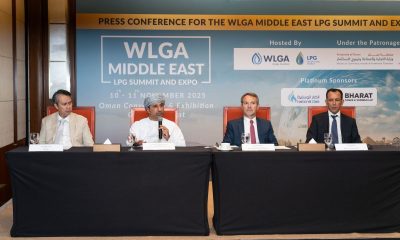Economy
Cluster in the making

Vinod Pittie, Chairman, ShriVallabh Pittie Group shares his views on the upcoming yarn plant in Sohar Freezone and its potential to create a one-of-its kind textile cluster in Oman. Mayank Singh reports
Can you share the reasons for setting up this plant in Sohar Freezone? Please give us a background of the group and tell us something about your yarn making project in Sohar Freezone?
Our group is over 100 years old as it was established in 1898, by my grandfather. The third generation of the family is now involved with the business and we have been in the textile business for over a century now. In India we are among the major cotton yarn and polyester yarn producers and exporters in India. We have 12 units in India and as a part of our expansion we thought of setting up projects in the GCC countries and out of all to them we chose Oman and specifically Sohar Freezone.
In India today we are facing three major problems in terms of capacity expansion and for these we found an alternative in Oman. One, the cost and quality of power in India is an issue and because yarn making is a 24/7 continuously running industry, it requires constant and reliable power. At Sohar Freezone we have been assured about continuous and good quality power at a competitive price. Second, the project is located at the port and all our exports can be routed through Sohar Port. As of now we export to Pakistan, Bangladesh, China, Turkey and other European countries from India. Our site in Sohar is a five minute drive from the port. So the logistic costs and infrastructure led advantages that we got at Sohar Freezone and in Oman prompted us to put up this project.
It’s a $300mn project with 3 lakh spindles and 7,000 routers. In yarn production there are two kinds of technologies that are used – one is ring spun which is spindles and the other one is open where we use routers. We will be setting up both kinds of plants here. They would be state-of-the art plants with high precision and the latest machinery which will ensure that our costs are on the lower side. In India too we have a similar capacity and specifications which we commissioned one and a half years ago. We will be importing the raw material in the form of cotton from India, USA and Australia and use it to make the final product.
How will Sohar and the larger economy benefit from the plant?
Textile is a very high employment oriented industry. If you look at countries that have developed economically, textile industry has been the main driving force. In addition to generating employment, textile industry leads to the development of infrastructure around it to service the needs to the people working there leading to the growth of the economy. This project can be called the anchor industry of textile as the spinning process is the most investment oriented process, the others being knitting, dyeing etc. Wherever an anchor yarn industry comes up all over the world, it helps downstream projects to come in due to the availability of yarn. After our project, a textile cluster may come up in Sohar and Oman.
Can you share the timelines of the various phases of the project?
The $300mn project has been divided into two phases of $150mn each. The first phase will be completed by March 2019, though in our projections to the banks and the government we have committed to commencing the project in 2020. We are happy to share that the project has been advanced by a year and we are planning to start production by March 2019. The reason for this advance in timelines is because in this industry machine supplies are very important and German and Japanese manufacturers usually take one and a half years to supply the machinery after they have been ordered, but because of our ongoing relationship with them, they have agreed to give us top priority, matching our revised delivery schedules. Based on their commitment we are trying to finish this project by March 2019. The open end technology project which consists of 3,500 routers with a project cost of $50mn is on course to start as early as October 2018. INEX Group from the UAE is our EPC contractor and they have 35 years of experience in the textile industry. Our group is known for speedy projects in India. Out of the $150mn outlay of the first phase, Bank Sohar has underwritten $105mn, and they have assured us that they will finance the second phase of the project too.
You mentioned about the probability of a textile cluster coming up in Sohar. What makes you confident about such a possibility?
Yarn is the first step in making textiles and after yarn you have to do weaving to make fabrics. For example, GCC market has a huge demand for fabrics like shirting’s, disdashas and abayas. Presently there are no fabric plants in the GCC. Once yarn production happens here, people will put up weaving, knitting, dyeing, processing and bleaching plants here. There is a lot of demand for denim nowadays so this is another possibility. All of these are high employment opportunity providers.
Can you please share the capacity of the plant and what will you be doing with the produced yarn?
The capacity of the plant is going to be 150 tonnes per day. The first phase will have a production capacity of 75 tonnes per day. We will be exporting the yarn that we produce here to countries like China, Bangladesh, Pakistan and European countries.
The textile industry is dominated by players from China and Bangladesh. What advantages does Oman offer?
The problem with China is that they were a high cotton producing country but over the last 10 years there has been a fall in the focus on cotton as they have prioritised foodgrains over cotton. Second, power tariffs in China are high and labour costs have gone up significantly in the last seven to eight years, hence China has diversified into processing like knitting, garmenting, bed sheets and towels compared to making yarn. As a result we are exporting huge quantities of yarn to China even from India. The same is happening in Bangladesh. As textile production requires a huge amount of labour and as this is cheap in Bangladesh the industry is more focused on downstream projects than making yarn. The pre requisites for making yarn making such projects economically viable are – projects should be located at the port, power costs should be low and the working environment needs to be good and Bangladesh lacks all these. Even in India we are exporting almost 60 per cent of our production to these countries. Sohar Port has developed so much that almost all the shipping lines are here and there is a lot of inward traffic. The outward shipping ratio is less so shipping companies would be keen to take our product and ship them at a very competitive price and that would be an advantage.
Will shipping from Oman add to your cargo transportation time?
Between India and Sohar (Oman) there is hardly any difference in shipping time. Shipping freight is a function of inward and outward traffic, if there is less of outward bound traffic then the freight charges are less. Even if freight prices move up in Sohar in future, it will still be competitive compared to what we pay in India.
How has the support been from government and Sohar Port?
We studied all the upcoming ports in the GCC before zeroing in on Oman. The main reasons why we choose Oman was because of three things – one, was the keenness of the senior government functionaries to have this project here, which we appreciated a lot. Second, the infrastructure that was readily available meant that we could go ahead start work. Third and most important was the friendliness and human touch of Omanis.
This is the world’s first textile projects which is being put up in a country where there is no cotton production and there is no market for yarn either. All around the world textile industry comes where there is a cotton belt, a yarn finished market or countries like Bangladesh where labour cost is low. Here all these conditions are adverse, but despite these the infrastructure and logistics available in Oman convinced us to set up this plant in Sohar Freezone.
-

 Alamaliktistaad Magazines2 months ago
Alamaliktistaad Magazines2 months agoAlam Al Iktisaad – September 2025 Edition
-

 Magazines2 months ago
Magazines2 months agoOER – September 2025 Issue
-

 News2 months ago
News2 months agoKitchenomiKs Secures Investment of US$3.2M Led by Jasoor Ventures
-

 News2 months ago
News2 months agoCent Capital, AI Finance App by ex-AWS Strategist ‘The Beast of Bay Area,’ Launches to End Financial Anxiety, Hits $1M AUM
-

 News2 months ago
News2 months agoOman Inaugurates ‘Hadatha’ – Its All-New Cybersecurity Center
-

 Banking & Finance2 months ago
Banking & Finance2 months agoOman Arab Bank Highlights Its Ongoing Strategic Initiatives and Future Plans
-

 News2 months ago
News2 months agoIEA Expects Global Oil Market to Remain Oversupplied in 2026
-

 Energy2 months ago
Energy2 months agoWLGA Middle East LPG Summit & Expo 2025 to be held at OCEC on November 10 and 11































You must be logged in to post a comment Login